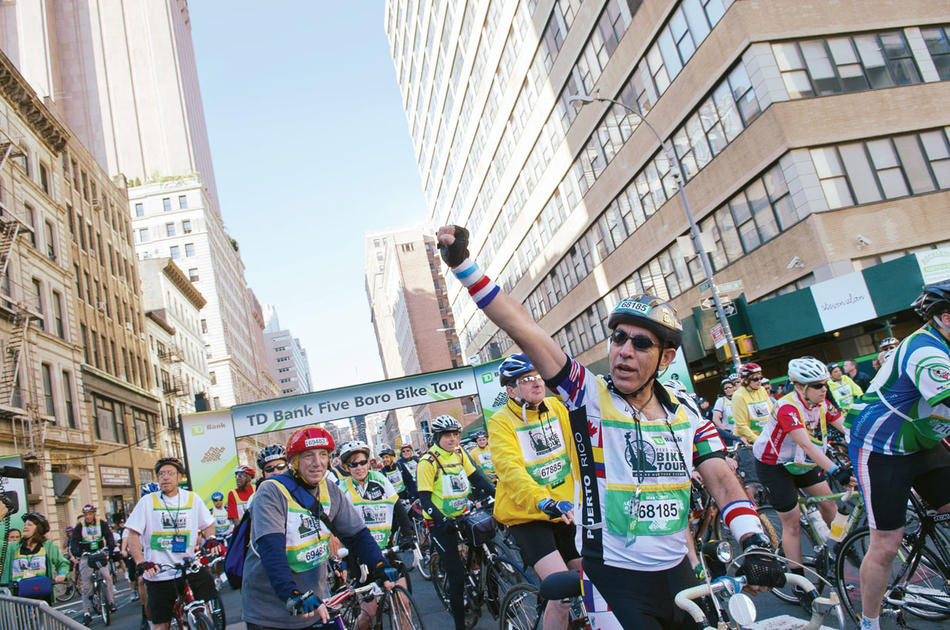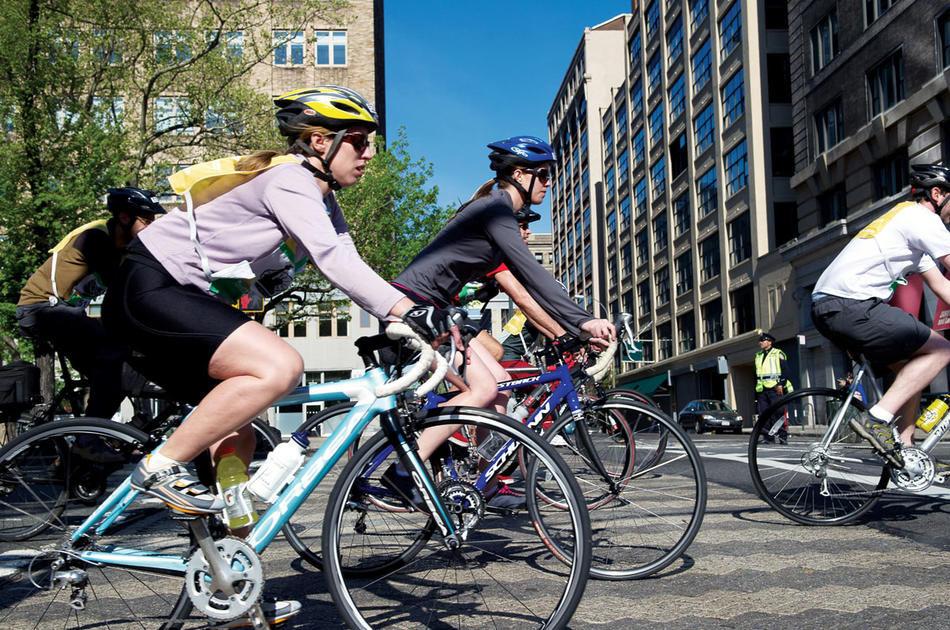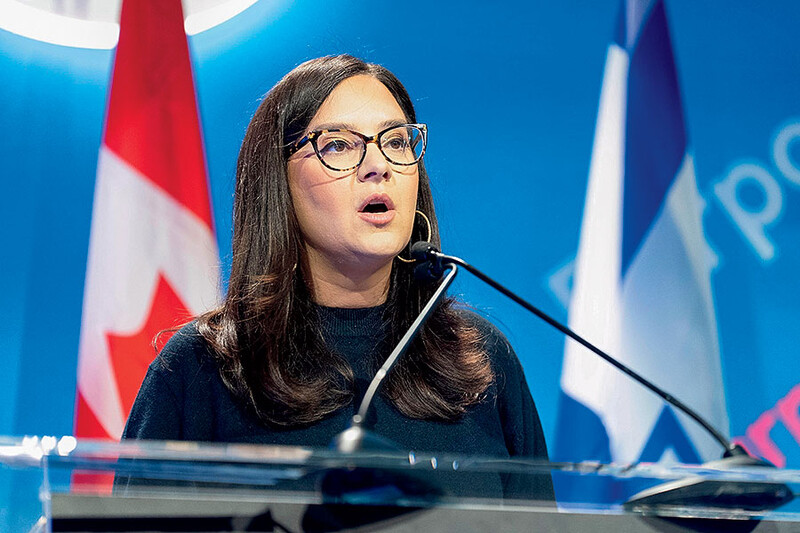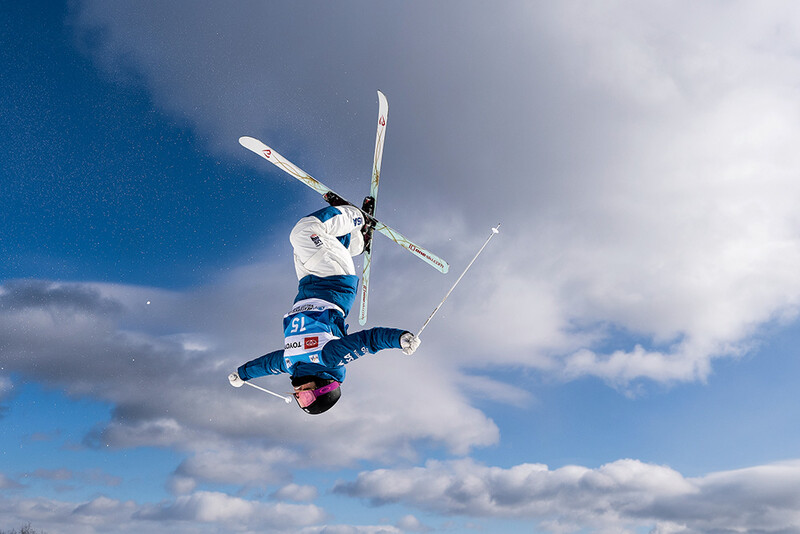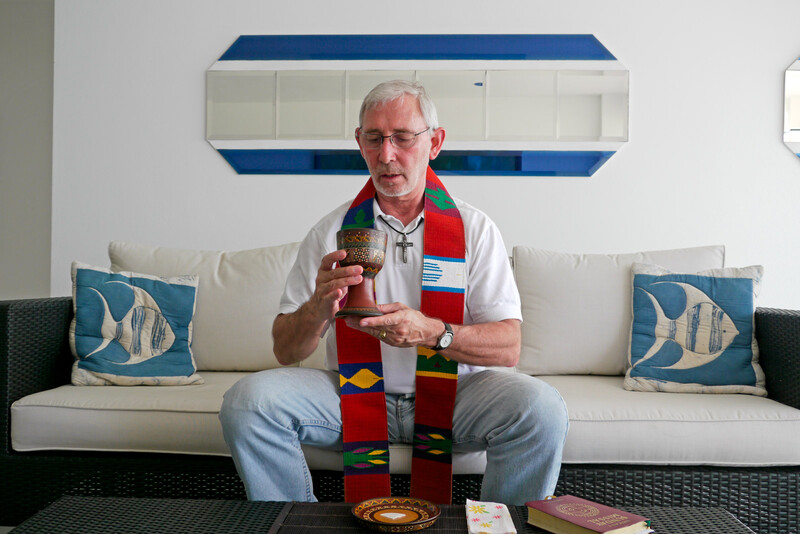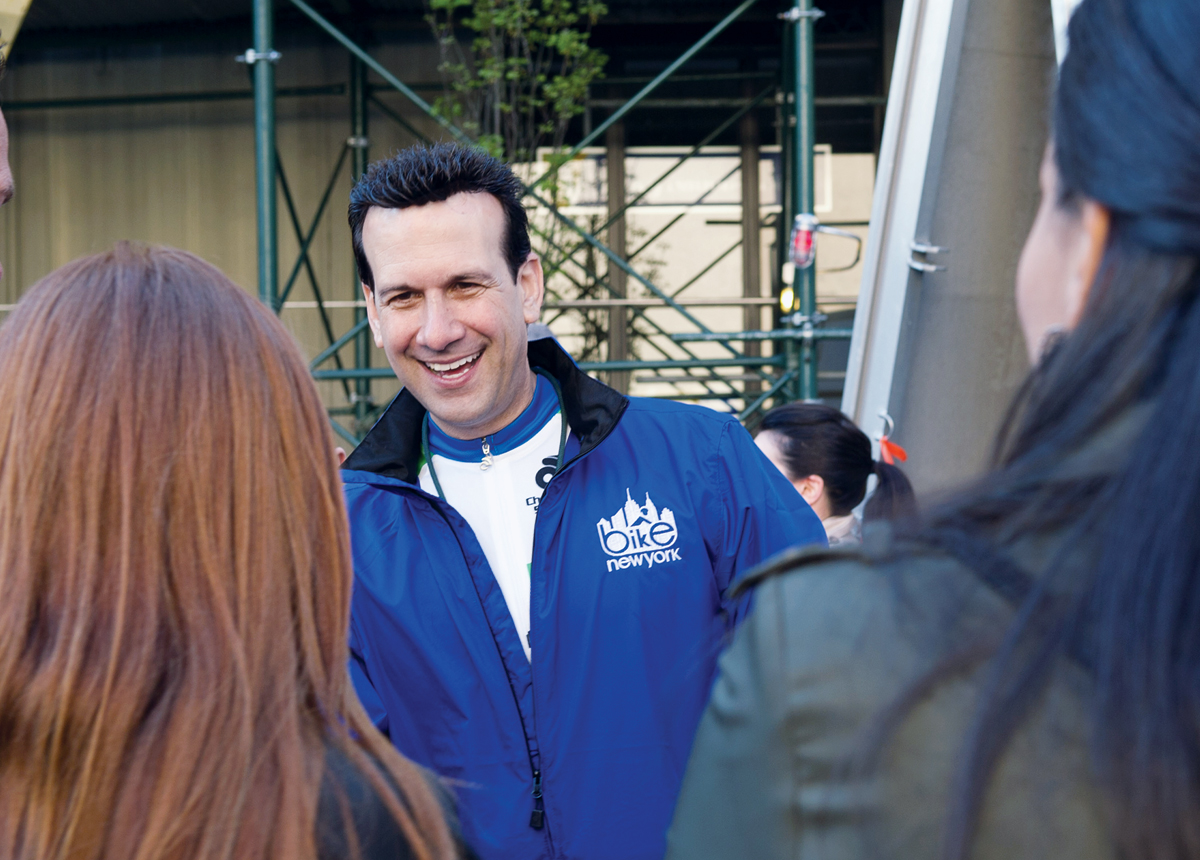
The New York City subways were full of bicycles on the first Sunday of May, packed with people on their way to Battery Park in Lower Manhattan, where thousands had been gathering since daybreak. They came from Queens, the Bronx, New Jersey, California, France. Weekend cyclists rubbed elbows (literally) with spandexed athletes straddling $5000 titanium frames. Manhattan office workers in wedge heels pedaled alongside nuclear families from Connecticut. On tandem bikes, the sighted rode with the vision-impaired, and wheelchair users propelled themselves on cycles powered by arm strength. And, as will happen at these endurance events, some riders wore tutus, or strapped boom boxes to their handlebars, or attached rubber chickens and stuffed flamingos to their helmets.
At the center of this sea of 32,000bicycles, Ken Podziba ’91GSAPP, president and CEO of Bike New York, smiled. The weather for the 34th annual TD Bank Five Boro Bike Tour, a 42-mile ride through car-free city streets, was perfect: a not-too-sunny day with a cool breeze. The tour, which sold out in just one day, is Bike New York’s signature event, and Podziba, now in his second year at the nonprofit, could look around and believe that bike culture in New York was accelerating faster than his own Cannondale SuperSix 3 on a Central Park straightaway. But could New Amsterdam really switch lanes and become more like, well, Amsterdam?
Podziba hopes so. While the Five Boro got the headlines, Bike New York’s overarching mission — to teach New Yorkers to be safe, courteous bikers who stop at red lights — would now kick into high gear. Summer was coming, and that meant more bikes on the streets, and, inevitably, more heated discussion over the vehicle’s proper place on what has long been, at least in Manhattan, a grid dominated by pedestrians and cars. On this day, however, the two-wheeler ruled. As the thousands of participants took off for uptown — Church Street north to Sixth Avenue to Central Park, up to the Bronx, down FDR Drive, over the Queensboro Bridge, through Astoria Park and Long Island City, over the Pulaski Bridge to Greenpoint and Williamsburg and over to Dumbo, down a stretch of the Brooklyn-Queens Expressway and across the Verrazano-Narrows — Podziba hitched a ride in the director of security’s car to the finish line on Staten Island.
As a kid, Ken Podziba spent a lot of time on wheels, but it was a skateboard, not a bike, that got him around the hamlet of Oceanside, Long Island. He went to college at Syracuse University, where he majored in advertising, then returned to his parents’ house after graduation. Determined to make some quick cash, he took a job in real estate, cold-calling lot owners to see if he could broker deals for them. He enjoyed researching the buildings and properties, and soon started looking for work as an urban planner at the New York City Department of Housing Preservation and Development (HPD).
“I showed up physically,” says Podziba. “I was very aggressive, very persistent, and I got an amazing job.”
One of Podziba’s first projects was Brooklyn’s MetroTech Center, a $1 billion revitalization project that his bosses didn’t think would fly. Podziba seized the chance: He met people and enlisted tenants for the center, a mixed-use facility that now houses the headquarters of the New York City Fire Department. Excited by the work, Podziba applied to Columbia’s Graduate School of Architecture, Planning, and Preservation. He began the Urban Planning Program in 1990. After graduating, he returned to the HPD, where he worked on the revitalization of South Street Seaport.
It was during this time that a chance encounter changed Podziba’s direction. He was at a party in a friend’s parents’ backyard, and among the guests was mayoral hopeful Rudolph Giuliani.
“I thought, ‘This is a man who could turn the city around,’” Podziba says, quickly adding that he’s not a Republican. Still, he threw himself into Giuliani’s campaign. He started out answering phones, and was soon digging up the voting records of other candidates in the race. After Giuliani won the election, he handed Podziba a Green Book, the official directory of the city’s government offices, and told him to choose the department where he wanted to work.
Podziba took a post as the assistant commissioner of finance at the New York City Community Development Office, a body that decides which community organizations to fund with federal money. The job satisfied “the social worker in me,” he says. Then he moved to the Taxi & Limousine Commission, where he led efforts to help New Yorkers with disabilities. He was also the mind behind those talking messages in taxis, with celebrities reminding passengers to buckle up.
Then, in 1998, Podziba got a call from City Hall.
“I was told, ‘Come right away and don’t tell anyone.’ I was really scared. I thought I was going to get fired.”
Instead, Mayor Giuliani and the deputy mayor for economic development, planning, and administration, Randy Levine, offered Podziba the job of sports commissioner.
“I wasn’t aware we had a sports commissioner,” Podziba remembers saying. “And they told me, ‘We do now.’” The New York City Sports Commission had just been created to attract sporting events to the five boroughs.
The first event Podziba brought to the city was outdoor bowling in Bryant Park with the Professional Bowlers Association. “It was live on CBS,” Podziba says. “The mayor rolled out the first ball.” Podziba served for 12 years, working to bring huge events like the 2014 Super Bowl to the
New Meadowlands Stadium in East Rutherford, New Jersey, while performing such civic errands as judging Nathan’s Famous Hot Dog Eating Contest in Coney Island. When Michael Bloomberg took office in 2001, Podziba was one of only a handful of government officials who were reappointed.
The centerpiece of Podziba’s wish list was the 2012 Olympic bid. He and his team needed to show the International Olympic Committee that the city was ready to host the games. “At the time, New York was only known as a professional sports town,” he says. “We needed to build a résumé for amateur events.”
In 2000, Podziba helped establish the New York City Triathlon, which includes a 40-kilometer bike ride on the Henry Hudson Parkway. The race, which was planned as a one-time event to impress the committee, is now in its 11th year. Podziba also worked with New York Road Runners to establish the New York City Half-Marathon, which starts in Central Park and ends on West Street in Tribeca. The Olympics bid was ultimately unsuccessful, although New York was among five cities to make the short list.
Being sports commissioner was gratifying, but the demands and the pace were intense. “I’m only one person,” Podziba says, “and I had a huge constituency — 8.3 million New Yorkers.” Podziba, the tireless pedaler, wanted to slow down, spend more time with his wife and two kids.
It’s one thing to streamline a bicycle. But how do you streamline your life?
In 2009, Podziba’s phone rang again. It was Bike New York, wanting to know if Podziba could recommend someone to replace the retiring executive director, Pam Tice. Podziba thought it over for three months, then called back to recommend himself, thinking the position would already be filled. It wasn’t. Podziba got the job.
On January 20, 2010, which Mayor Bloomberg proclaimed “Ken Podziba Day,” Podziba left city government. After a long weekend, he began his new role at Bike New York.
“As sports commissioner, I was spread so thin,” he says. “Now I can focus on bicycling and dive into the project to the fullest.”
Bikers had already experienced bottlenecks in Central Park and at the entrances to several bridges along the tour route. When they arrived at the BQE, most were excited to be back on a wide thoroughfare. Although Bike New York had issued warnings about construction, no one — not the riders or the Bike New York staff — anticipated the extent of the delays ahead of them.
For those who began the tour right at 7 a.m., there were no problems. But riders who started later found themselves stuck on the BQE in the late afternoon. Delays of up to two hours kept thousands standing in wheel-to-wheel traffic just before the exit to the Verrazano-Narrows Bridge, waiting to merge from three lanes to one. Some fumed about the “Five Boro Walking Tour.” Veterans said they’d never encountered delays like this in the past. Others turned around and biked back to Dumbo instead of pushing to make it to Staten Island.
For many, the Verrazano-Narrows Bridge, generally closed to pedestrians and cyclists, is one of the highlights of the ride, and was worth the wait. Podziba knew how complicated such events could be in a city of millions, but even his years as sports commissioner didn’t prepare him for the bumps in this year’s tour. The road construction reminded everyone that the byways of New York still belonged to Toyota, Ford, and General Motors.
Podziba once had a car.
As sports commissioner, he enjoyed the privileges of a town car and a parking space in front of his apartment just in case he had to speed out to Queens to distribute trophies or give a proclamation at Gracie Mansion. But when he left city government, he also left behind, more or less, the internal combustion engine. Now he rides his Cannondale to work every day, cruising from his home on York Avenue and East 71st Street through Central Park to Bike New York’s new offices at the Interchurch Center, across the street from Barnard College. It takes him about 20 minutes.
“I’m more connected when I bike,” he says. “I’m healthier, I’m breathing fresh air, I’m more alert when I get to work.”
Bike New York moved to Interchurch just a few months before this year’s tour, leaving its original home at the American Youth Hostels building on Amsterdam at West 103rd Street, where the Five Boro Challenge was organized in 1977 as a way to teach and practice bike safety in the city. When Bike New York was formed to organize the event in 2000, the number of participants had grown from a few hundred to about 20,000. It cost $7 to enter, and there was precious little in the way of Porta-Potties and snacks along the route. These days the tour has rest areas in every borough, where people can also compost banana peels and refill water bottles with New York City tap water. The entry fee, now $75, helps support Bike New York’s ambitious education initiatives.
Podziba has greatly expanded this public outreach. Bike New York holds bike-safety and maintenance classes for adults and has designed a bike-safety curriculum for teachers to use in the classroom. After piloting the program in city schools, Bike New York education director Emilia Crotty realized the organization needed to go further.
“Teachers were saying, ‘We love your organization, we love what you’re doing, but our kids don’t have bikes,’” Crotty says.
Last year, Bike New York organized a series of Bike Bonanzas, where kids can get a used bike or swap a bike for a better one. The Department of Transportation (DOT) provides helmets and bike maps, and the Bike New York team teaches students the rules of the road — a road that is getting more and more crowded each year.
According to DOT’s 2010 Sustainable Streets Index, commuter cycling increased more than 262 percent in the past decade. Under Bloomberg, the city has added over 200 miles of bike lanes to many streets, and a bike-share program, proposed by the DOT, is in the works. While the program is still in the planning stages, Podziba says it could open up a whole new world for New Yorkers.
“In New York, we tend to stay in our neighborhoods. How great would it be if I could just say to my wife, ‘Let’s go to the East Village’ and not have to spend $20 on cabs?” (Podziba’s York Avenue address is four long blocks from the nearest subway.) For $50 a year, residents could have unlimited bicycle access, and rides under 30 minutes would be free, Podziba says. The DOT hopes the bike-share program will begin in the spring of 2012.
But as many pedestrians, motorists, and cyclists can attest, Bike New York has a lot of teaching to do. Many riders blow through red lights and travel the wrong way on one-way streets. Community groups in Manhattan and Brooklyn have organized protests against the added lanes and bicycle traffic in their neighborhoods. Police have increased the number of tickets given out to scofflaw riders in recent months, especially in and around Central Park.
Podziba is convinced that with enough education, the bike culture in New York will evolve and harmonize with the city’s cars, buses, taxis, joggers, walkers, and delivery trucks. The curve in the road he is most concerned with is the learning curve.
The Five Boro Festival ended at mile 39 on Staten Island, with food, raffles, a rest area, and information booths for those interested in learning more about cycling in the city. Podziba and the Bike New York staff were there to celebrate, but were also posting traffic-jam updates on Facebook and Twitter.
A few days after the race, Podziba posted a letter on Facebook to address the complaints from angry riders that had lit up Bike New York’s Facebook and Twitter accounts.
“In the previous months,” wrote Podziba, “we made planning and logistical decisions for the Tour, taking into consideration construction schedules and other outside information. We were fully aware of potential delays and made plans to deal with them. However, the reality is that the delays were greater than we anticipated and planned for.”
Podziba and the Bike New York staff have taken rider comments to heart and are working to make sure similar problems don’t affect future tours. Podziba personally telephoned many riders who complained about delays, and already has been meeting with DOT and NYPD officials about next year’s route.
“It’s all about coordination,” Podziba says. “I wish we could just fast-forward to 2012 — it’s going to be an excellent event.”
